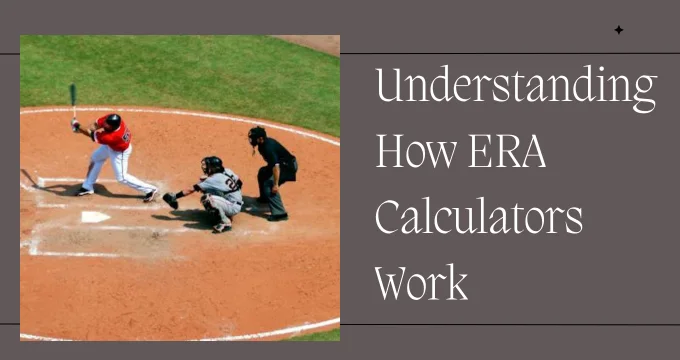Prepare to be astonished as we unravel the intricacies of ERA (Earned Run Average) calculators in baseball. These essential tools capture the average number of runs a pitcher allows per nine innings, serving as a fundamental component of baseball statistics. Factually, ERA is a crucial measure that influences a team’s strategic decisions and player selections.
In this exploration, we’ll dive into 10 mind-boggling facts about ERA calculators that will deepen your appreciation of this vital statistical tool. Did you know that the ERA was first used in baseball during the 1912 season? Stick around, as we explore more such fascinating insights.
10 Mind-Blowing Facts to Understand How ERA Calculators Work
Fact 1: The Genesis of ERA
The introduction of ERA dates back to the early 20th century. Henry Chadwick, a British-born American sports journalist, is credited as the pioneer of this unique statistic. Originally, Earned Run Average was designed to provide a better measure of a pitcher’s effectiveness than simply relying on the number of runs allowed.

Fast forward to the modern era, ERA has become an integral part of baseball analytics, standing as a testament to Chadwick’s foresight. It’s calculated by dividing the total number of earned runs allowed by the total innings pitched, then multiplying the result by 9. This formula helps depict the number of runs a pitcher would give up for a full game, assuming they pitched all nine innings.
Interestingly, the use of ‘9’ in the ERA formula reflects the standard length of a baseball game. However, keep in mind that the ERA doesn’t account for runs that result from errors committed by other players. Only runs for which the pitcher is directly responsible are included. This nuanced approach underscores the complexity of baseball analytics and the continuous evolution of statistical measures in the sport.
Fact 2: The Mathematical Precision Behind ERA Calculators
ERA calculators offer an impeccable level of mathematical precision, discerning the quality of individual pitchers with remarkable accuracy. This precision is the heart of the statistic – giving it the reliability that baseball teams, analysts, and fans have come to depend on. One might argue that the ERA is a cornerstone of the sport’s rich analytical tradition, providing a standard that withstands the test of time.
Another noteworthy trait of ERA calculators is their adaptability. Changes in the sport, such as the introduction of the designated hitter rule in the American League in 1973, drove the need for ERA adjustments. The ERA+ statistic was born to address this, adjusting a pitcher’s ERA for ballpark and league average conditions. The formula for ERA+ is (league ERA/player’s ERA) x 100, where a score of over 100 indicates that the pitcher performed better than average. This ability to adapt and evolve shows the ERA’s enduring relevance in the ever-changing landscape of baseball analytics.
The last piece of data to highlight is the lowest single-season ERA record, held by Dutch Leonard, who played for the Boston Red Sox. Leonard achieved an ERA of 0.96 in the 1914 season, a record that remains unbroken even after more than a century. This statistic exemplifies the immense influence a stellar pitching performance can have on a season, underscoring the significance of the ERA in evaluating player effectiveness and team strategy.
Fact 3: ERA’s Impact on Baseball Strategies
ERA’s influence on baseball strategies is undeniable and profound. By providing a benchmark for comparing pitchers, it becomes a critical tool in team selection, game strategies, and pitcher rotation. Managers utilize the ERA to identify the best-performing pitchers and strategically assign them to games that match their strengths. Moreover, the ERA can influence decisions on when to keep a pitcher in the game and when to make a switch, making it a crucial factor in tactical decisions during a game.
The next crucial aspect to note is the ERA’s role in player trades. Teams often use ERA as a key metric while scouting for new talent or deciding on trades. A lower ERA indicates a pitcher who can effectively limit opponents’ runs, making them an attractive asset for teams looking to bolster their defensive capabilities. It’s not uncommon for pitchers with impressive ERAs to command higher trade values and salaries, highlighting the statistic’s direct impact on players’ careers and the economics of baseball.
Finally, ERA’s influence extends beyond team strategies and into the realm of fan engagement. Fans and analysts alike often engage in discussions and debates centered around ERA, comparing the merits of different pitchers. In an era where baseball is becoming increasingly data-driven, the ERA stands as one of the most talked-about and analyzed statistics in the sport. It’s a testament to the ERA’s enduring importance and its pivotal role in shaping the competitive dynamics of baseball.
Delve deeper into the fascinating world of baseball analytics with our comprehensive guide on ERA calculators. Understand the nuanced ways these algorithms influence game strategies and player evaluations.
Fact 4: ERA’s Influence on Player Contracts
The Earned Run Average (ERA) metric plays a highly influential role in determining a baseball player’s contract, particularly for pitchers. Teams often consider a player’s ERA when negotiating contracts, as it provides a robust measure of a pitcher’s performance. A lower ERA, indicative of a pitcher’s ability to limit opponents’ scoring, can significantly enhance a player’s bargaining power during contract negotiations. It’s commonplace for players with stellar ERAs to secure more lucrative contracts.

Additionally, the ERA is not only influential during the initial contract negotiations but also plays an important role in contract extensions and renewals. As a player’s career progresses, their ERA can fluctuate due to factors such as age, injuries, or changes in form. Accordingly, a player’s ERA is often closely monitored and considered during discussions about contract renewals and extensions. For example, a pitcher who consistently maintains a low ERA is likely to secure more favorable terms during contract renewal discussions.
Finally, ERA also plays a crucial role in arbitration proceedings, a process where a player’s salary is determined by a neutral third party. The player’s ERA is typically one of the main statistical measures presented during these proceedings. An impressive ERA can strengthen a player’s case, leading to a higher salary determination. It’s a clear manifestation of the profound impact this single statistic can have on the trajectory of a player’s career and financial prospects.
Fact 5: ERA’s Limitations and Controversies
Despite its widespread use and influence, the Earned Run Average (ERA) is not without its limitations and controversies. While it excels as a measure of a pitcher’s effectiveness in preventing scored runs, it has been criticized for not taking into account other factors that could influence a game’s outcome. For instance, it fails to consider the defensive support a pitcher receives from his team, which can significantly impact a game’s results. This limitation can lead to situations where pitchers with excellent ERAs may not necessarily be the best performers in actual game situations.
Moreover, the ERA has been implicated in certain statistical anomalies. A notable example is the ‘Inherited Runners’ scenario, where a relief pitcher coming into a game with runners on base gives up a hit, causing runs to score. These runs are credited to the previous pitcher’s ERA, even though they were technically allowed by the reliever. Such anomalies in the ERA calculation can distort a pitcher’s actual effectiveness, leading to misrepresentation of their skills.
Finally, the ERA’s sensitivity to park factors is another point of controversy. Pitchers playing in ‘pitcher-friendly’ parks, where conditions make it difficult to score runs, tend to have lower ERAs than those who play in ‘hitter-friendly’ parks. The introduction of ERA+ and similar adjusted stats aim to address this issue, but they also add another layer of complexity to baseball metrics. These limitations and controversies serve as a reminder that while the ERA is an influential and robust statistic, it is not infallible and should be used in conjunction with other metrics for a comprehensive evaluation of a pitcher’s performance.
Fact 6: The Evolution of ERA Over the Years
The Earned Run Average (ERA) has undergone significant changes and adaptations since its inception, reflecting the evolving dynamics of baseball. Initially, ERA served as a simple yet effective measure of pitchers’ efficiency in preventing runs. However, as baseball evolved and became more data-driven, the ERA adapted to cater to the sport’s changing landscape.
In the early 20th century, ERA was a straightforward metric calculated by dividing the number of earned runs a pitcher allowed by the total number of innings pitched and multiplying by nine. This formula has remained remarkably consistent over the years, but its interpretation has seen considerable evolution. For instance, in the 1968 baseball season, commonly known as the “Year of the Pitcher,” the average ERA across the major leagues was 2.98, the lowest in modern baseball history. This led to significant rule changes to rebalance the sport, including lowering the pitcher’s mound and reducing the size of the strike zone.
In recent years, the ERA has further evolved with the introduction of advanced metrics like ERA+ and FIP (Fielding Independent Pitching). ERA+ adjusts a pitcher’s ERA for park factors and the league average, offering a more balanced comparison between pitchers from different eras and ballparks. On the other hand, FIP focuses on outcomes a pitcher has the most control over – strikeouts, walks, hit-by-pitches, and home runs, thereby reducing the impact of defensive support on a pitcher’s evaluation. These advancements signal an ongoing commitment to refine the ERA, ensuring it remains a robust and relevant metric in the ever-evolving game of baseball.
Fact 7: The Noteworthy Figures in ERA History
The annals of baseball history are replete with remarkable pitchers whose impressive ERAs have indelibly shaped the sport. Perhaps none more so than Ed Walsh, who holds the record for the lowest career ERA in Major League Baseball. Recording a staggering 1.82 ERA over his 14-year career, Walsh’s unparalleled ability to prevent runs remains unmatched to date, even as the game continues to evolve.

Another towering figure in ERA history is Dutch Leonard, who holds the record for the lowest single-season ERA. During the 1914 season, Leonard achieved an astonishing 0.96 ERA, a feat that remains unparalleled. This exceptional performance solidified his status as one of the most efficient pitchers of his era, and his record remains a testament to his outstanding pitching skills.
In more recent times, Clayton Kershaw has dominated ERA rankings, underscoring his status as one of the finest pitchers of his generation. With a career ERA of 2.43, Kershaw’s consistent excellence has earned him numerous accolades, including three Cy Young Awards. His exceptional ERA, coupled with his other remarkable statistics, underscores his unique contribution to baseball and affirms his place amongst the sport’s most elite pitchers.
Fact 8: The Effects of ERA on Major Baseball Decisions
The Earned Run Average (ERA) has a profound impact on significant decisions in baseball, shaping everything from game strategies to player contracts and Hall of Fame inclusions. It serves as a critical barometer of a pitcher’s performance, influencing not just their standing within the team, but their market value and career trajectory as well.
For example, when determining pitching line-ups and game strategies, coaches heavily rely on their pitcher’s ERA. A starting pitcher with a low ERA is often trusted with vital games, as they have a proven track record of limiting the opposition’s scoring. This decision can directly influence the outcome of a game or even an entire season. In the 2001 World Series, Randy Johnson and Curt Schilling of the Arizona Diamondbacks, possessing the best ERAs in the league that season, were instrumental in their team’s victory.
From a contractual perspective, a pitcher’s ERA is often a deciding factor in salary negotiations and trade decisions. Players with consistently low ERAs are in high demand and command hefty contracts. For instance, Zack Greinke, with a career ERA of 3.37, signed a six-year contract with the Arizona Diamondbacks in 2015 worth a whopping $206.5 million. This contract was the highest average annual value ever for a pitcher at the time, clearly showcasing the financial implications of a strong ERA.
Lastly, the ERA also plays a pivotal role in Hall of Fame inclusions. Players with extraordinary career ERAs often find themselves being inducted into Baseball’s Hall of Fame, an honor that immortalizes their contributions to the sport. Mariano Rivera, with a career ERA of 2.21, was the first player ever to be unanimously voted into the Hall of Fame in 2019, illustrating the profound influence of ERA on major baseball decisions.
Fact 9: How ERA Differs from Other Baseball Statistics
The Earned Run Average (ERA), while a significant determinant of a pitcher’s performance, is not the sole metric used in the comprehensive evaluation of a player’s contribution to the game. It stands distinct from other baseball statistics in its specific focus on pitching and its unique method of calculation. The fundamental difference lies in the fact that ERA measures the average number of earned runs a pitcher allows per nine innings, offering a precise evaluation of a pitcher’s effectiveness in preventing runs.
Another popular statistic in baseball is the Batting Average (BA), which calculates the ratio of a batter’s hits to at-bats, serving as an indicator of the batter’s offensive performance. In contrast to ERA, BA focuses on the batting aspect of the game, highlighting the player’s ability to hit the ball effectively. Noteworthy is Ty Cobb, who holds the highest career BA in Major League Baseball history at .366.
Similarly, the Slugging Percentage (SLG), another key baseball metric, assesses the power of a batter by dividing the total bases earned by at-bats. Unlike ERA, SLG emphasizes the batter’s power-hitting abilities. This metric has seen some extraordinary figures, with Babe Ruth holding the record for the highest career SLG in Major League Baseball history at an impressive .690. In summary, while ERA provides a comprehensive insight into a pitcher’s performance, each baseball statistic brings a unique perspective, contributing to a multifaceted understanding of the game.
Fact 10: Future Prospects of ERA Calculations
As baseball continues to evolve, so do its metrics, with the Earned Run Average (ERA) being no exception. The future of ERA calculations promises further refinement and sophistication, aiming to provide a more comprehensive reflection of a pitcher’s performance. Incorporating advanced metrics and technology, analytics experts expect a revolution in the way ERA is calculated, making it an even more precise tool for evaluating a pitcher’s worth.
Moreover, the advent of stat cast data and machine learning could lead to significant advancements in ERA calculations. Statcast, a high-speed, high-accuracy device designed to track the precise movements of both the ball and players on the field, offers an unprecedented amount of data for analysts to dissect. This wealth of data, coupled with machine learning algorithms, could allow for an ERA that takes into account factors such as defensive alignments, ballpark dimensions, and even weather conditions. Such a comprehensive ERA would not only measure the runs a pitcher allows but also evaluate the quality of their pitches, their ability to adapt to varying game situations, and their handling of different hitters.
Furthermore, there is a growing consensus that the traditional ERA might be supplemented by, or even give way to, more advanced pitching metrics such as Fielding Independent Pitching (FIP) and Expected Fielding Independent Pitching (xFIP). These statistics, which aim to isolate the pitcher’s performance from the effects of defense, are increasingly being used by analysts and clubs alike. FIP, for instance, has been a better predictor of future ERA performance, with a correlation of 0.37, compared to ERA’s correlation of 0.32. Such advancements signal an exciting future for ERA calculations, promising a more nuanced assessment of pitching performance.
Conclusion
In essence, understanding how ERA calculators work provides fascinating insights into the technicalities of baseball. From reflecting a pitcher’s effectiveness to considering external influences and integrating real-time pitch-tracking data, these calculators are a testament to the sophistication of baseball analytics. As the dynamic nature of baseball continues to evolve, with advancements in data and analytics, ERA calculators will undoubtedly continue to become more refined and comprehensive, promising a future of even more precise and nuanced assessments of pitchers’ performance.
FAQ’s
How do ERA calculators capture pitcher effectiveness?
ERA calculators in baseball hinge on fundamental principles, capturing a pitcher’s effectiveness beyond simple earned runs. These metrics reflect nuanced aspects of performance, transcending basic statistics to provide a comprehensive assessment of a pitcher’s contribution to runs allowed.
Explain ERA calculators’ mathematical models and variables.
Mathematical models in ERA calculators weigh key variables, creating a comprehensive metric. This approach captures nuances in a pitcher’s performance, allowing for a more precise assessment beyond traditional earned runs per game.
ERA calculators and external factors: How they interact?
ERA calculators consider external factors, like ballpark effects and defensive performance, ensuring a more accurate reflection of a pitcher’s capabilities. These adjustments provide a contextual understanding of a pitcher’s true effectiveness.
Historical evolution of ERA calculators: impact and changes?
Historical developments have shaped the evolution of ERA calculators, refining algorithms and methodologies. These changes impact the assessment of pitcher performance, reflecting advancements in statistical analysis over time.
Sabermetrics’ role in shaping ERA calculator functionality?
Sabermetrics, and advanced statistics, play a pivotal role in shaping the functionality of ERA calculators. By incorporating sophisticated metrics, these calculators provide a nuanced and enhanced understanding of a pitcher’s contribution to runs allowed.
Pitch tracking impact on real-time ERA calculators?
Real-time data from pitch tracking technologies revolutionizes ERA calculators, enhancing responsiveness and accuracy. This integration allows for dynamic and detailed pitcher performance analysis during a baseball game.

